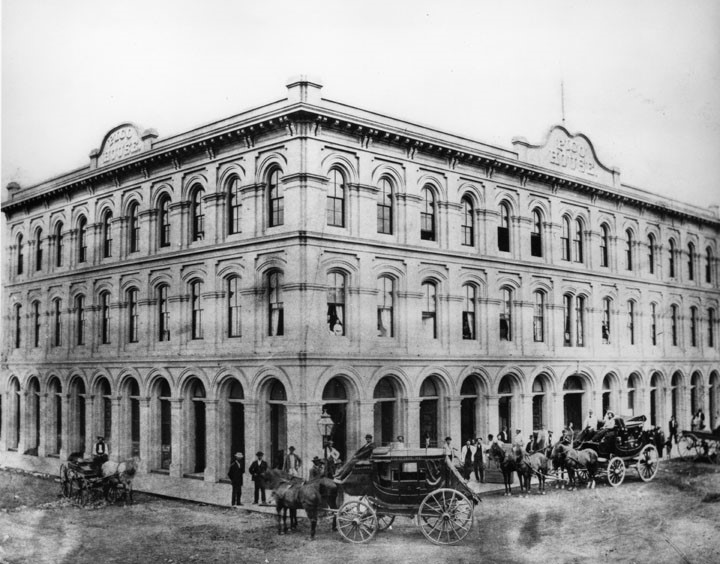When my daughter was in 4th grade California history class, her teacher arranged a field trip to Olvera Street. A stay-at-home mom, I volunteered to help out.
It was a beautiful spring day. Our docent was an energetic young lady, extremely knowledgeable. She guided us through the Avila Adobe, L.A.’s oldest home, and the historic fire station. She explained the Pico House was once the most extravagant and luxurious hotel in all of Southern California. Completed in 1870, it originally boasted a courtyard fountain and exotic bird aviary. Looking through the windows, no one was impressed. The hotel was little more than a shell with a rubbish-strewn floor.

The Pico House in its heyday
Our guide had a special surprise for us—something that was not usually part of her tour. We walked down a stairwell on the side of the Pico House, then came to a locked metal gate. She produced a key and accessed another stairway. We descended deep underground, finally entering a cavernous space.
This, she explained, was the site of an underground Chinatown, where the Chinese worked, shopped, and even built homes away from the discrimination all too common above ground. In the distance, a single shaft of sunlight gave us some perspective on the enormity of the area. She confirmed the cave ran blocks to the east, under Union Station, which was the site of L.A.’s original Chinatown. Since the space would soon be utilized to construct a subway system, no one would see this area again; the reason she shared it with us.

The 1890s above-ground Chinatown well before it was bulldozed to make room for Union Station
Many artifacts had been recovered from the cave and were destined for display in the yet-to-be-built Chinese-American Museum. Our guide captured my imagination. I made it a point to visit the museum every time I found myself on Olvera Street. It was never open.
I always remembered that field trip, so when I had an opportunity to include the lost underground city in Catching Nettie Gordon, I began research on the internet. Surprisingly, the subterranean Chinatown was only listed as an urban legend. Even that information was difficult to find.
A few years ago, my husband, our oldest son and I planned an L.A. Conservancy tour of Union Station. We took the subway downtown, did our tour, and headed for Olvera Street and lunch. Coincidentally, it was a “free museum day” and all the small museums located in and around Olvera Street were open, including the Chinese-American Museum.
Aside from a few examples of pottery in the lobby, I couldn’t find a trace of the artifacts I’d longed to see. After touring the museum, I approached the cashier and asked if he was familiar with the displays and history of the area. Since the facility is small, everyone who works and volunteers there must be a jack-of-all-trades.
I explained the long-ago field trip and my descent underground. He proclaimed he was one of the few people who worked at the museum to be allowed down the Pico House staircase. He saw a small concrete room and nothing else.
“Of course,” I replied. “The subway is there now.”
Unable to envision any scenario other than the one he’d seen, he brushed my inquiry aside, explaining the underground Chinatown was nothing more than an urban legend. He was not interested in my experience. I left disappointed.
After confirming my memory with others who went on the field trip, I felt somewhat less crazy. In the end, the underground city of my imagination is what made it into my book. I can’t help but wonder if all history is so ephemeral.

The now-restored ground floor of the Pico House is currently used for exhibits and other events
